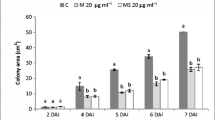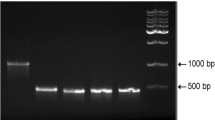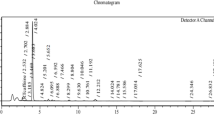Abstract
Bacillus subtilis SPB1 lipopeptides were evaluated as a natural antifungal agent against Fusarium solani infestation. In vitro antifungal assay showed a minimal inhibitory concentration of about 3 mg/ml with a fungicidal mode of action. In fact, treatment of F. solani by SPB1 lipopeptides generated excessive lyses of the mycelium and caused polynucleation and destruction of the related spores together with a total inhibition of spore production. Furthermore, an inhibition of germination potency accompanied with a high spore blowing was observed. Moreover, in order to be applied in agricultural field, in vivo antifungal activity was proved against the dry rot potato tubers caused by F. solani. Preventive treatment appeared as the most promising as after 20 days of fungi inoculation, rot invasion was reduced by almost 78 %, in comparison to that of non-treated one. When treating infected tomato plants, disease symptoms were reduced by almost 100 % when applying the curative method. Results of this study are very promising as it enables the use of the crude lipopeptide preparation of B. subtilis SPB1 as a potent natural fungicide that could effectively control the infection of F. solani in tomato and potato tubers at a concentration similar to the commercial fungicide hymexazol and therefore prevent the damage of olive tree.







Similar content being viewed by others
References
Al-Reza SM, Rahman A, Ahmed Y, Kang SC (2010) Inhibition of plant pathogens in vitro and in vivo with essential oil and organic extracts of Cestrum nocturnum L. Pestic Biochem Physiol 96:86–92
Cao Y, Xu Z, Ling N, Yuan Y, Yang X, Chen L, Shen B, Shen Q (2012) Isolation and identification of lipopeptides produced by B. subtilis SQR 9 for suppressing Fusarium wilt of cucumber. Sci Hortic 135:32–39
Cazorla FM, Romero D, Pérez-Garcia A, Lugtenberg BJJ, de Vicente A, Bloemberg G (2007) Isolation and characterization of antagonistic Bacillus subtilis strains from the avocado rhizoplane displaying biocontrol activity. J Appl Microbiol 103:1950–1959
Chitarra GS, Breeuwer P, Nout MJR, van Aelst AC, Rombouts FM, Abee T (2003) An antifungal compound produced by Bacillus subtilis YM 10–20 inhibits germination of Penicillium roqueforti conidiospores. J Appl Microbiol 94:159–166
Daami-Remadi M, Jabnoun-Khiareddine H, Ayed F, Hibar K, Znaidi IEA, El Mahjoub M (2006) In vitro and in vivo evaluation of individually compost fungi for potato Fusarium dry rot biocontrol. J Biol Sci 6(3):572–580
De Corato U, Viola E, Arcieri G, Valerio V, Cancellara FA, Zimbardi F (2014) Antifungal activity of liquid waste obtained from the detoxification of steam-exploded plant biomass against plant pathogenic fungi. Crop Prot 55:109–118
des Grades ZE, der Agrarwissenschaften D, Fakultät HL, Wilhelms RF (2012) Biological control of leaf pathogens of tomato plants by Bacillus subtilis (strain FZB24): antagonistic effects and induced plant resistance. Inaugural-Dissertation, Institute of Crop Science and Resource Conservation—Phytomedicine, vorgelegt am 06.06.2012
Ebtsam MM, Abdel-Kawi KA, Khalil MNA (2009) Efficiency of Trichodermaviride and Bacillus subtilis as biocontrol agents against Fusarium solani on tomato plants. Egypt J Phytopathol 37:47–57
El-Kassas HY, Khairy HM (2009) A trial for biological control of a pathogenic fungus (Fusarium solani) by some marine microorganisms. Am Eurasian J Agric Environ Sci 5:434–440
Ghribi D, Abdelkefi-Mesrati L, Mnif I, Kammoun R, Ayadi I, Saadaoui I, Maktouf S, Chaabouni-Ellouze S (2012) Investigation of antimicrobial activity and statistical optimization of Bacillus subtilis SPB1 biosurfactant production in solid-state fermentation. J Biomed Biotechnol. doi:10.1155/2012/373682
Hammami I, Rhouma A, Jaouadi B, Rebai A, Nesme X (2009) Optimization and biochemical characterization of a bacteriocin from a newly isolated Bacillus subtilis strain 14B for biocontrol of Agrobacterium spp. strains. Lett Appl Microbiol 48:253–260
Hammami I, Triki MA, Rebai A (2011) Purification and characterization of the novel bacteriocin Back IH7 with antifungal and antibacterial properties. J Plant Pathol 93:443–454
Hu LB, Shi ZQ, Zhang T, Yang ZM (2007) Fengycin antibiotics isolated from B-FS01 culture inhibit the growth of Fusarium moniliforme Sheldon ATCC38932. FEMS Microbiol Lett 272:91–98
Jing L, Yang Q, Zhao L-H, Zhang S-M, Wang Y-X, Zhao X-Y (2009) Purification and characterization of a novel antifungal protein from Bacillus subtilis strain B29. J Zhejiang Univ Sci B 10:264–272
Kim PI, Bai H, Chae H, Chung S, Kim Y, Park Y, Chi Y-T (2004) Purification and characterization of a lipopeptide produced by Bacillus thuringiensis CMB26. J Appl Microbiol 97:942–949
Kita N, Ohya T, Uekusa H, Nomura K, Manago M, Shoda M (2005) Biological control of damping-off of tomato seedlings and cucumber Phomopsis root rot by Bacillus subtilis RB14-C. Jpn Agric Res Q 39:109–114
Leclère V, Béchet M, Adam A, Guez J-S, Wathelet B, Ongena M, Thonart P, Gancel F, Chollet-Imbert M, Jacques P (2005) Mycosubtilin overproduction by Bacillus subtilis BBG100 enhances the organism’s antagonistic and biocontrol activities. Appl Environ Microbiol 71:4577–4584
Leelasuphakul W, Hemmanee P, Chuenchitt S (2008) Growth inhibitory properties of Bacillus subtilis strains and their metabolites against the green mold pathogen (Penicillium digitatum Sacc.) of citrus fruit. Postharvest Biol Technol 48:113–121
Li L, Ma MC, Huang R, Qu Q, Li GH, Zhou JW, Zhang KQ, Lu KP, Niu XM, Luo J (2012) Induction of chlamydospore formation in Fusarium by cyclic lipopeptide antibiotics from Bacillus subtilis C2. J Chem Ecol 38:966–974
Lin HF, Chen TH, Liu SD (2010) Bioactivity of antifungal substance iturin A produced by Bacillus subtilis strain BS-99-H against Pestalotiopsis eugeniae, a causal pathogen of wax apple fruit rot. Plant Pathol Bull 19:225–233
Matar SM, El-Kazzaz SA, Wagih EE, Al-Diwany AI, Moustafa HE, Abo-Zaid GA, Abd-Elsalam HE, Hafez EE (2009) Antagonistic and inhibitory effect of Bacillus subtilis against certain plant pathogenic fungi, I. Biotechnology 8:53–61
Mnif I, Sahnoun R, Ellouze-Chaabouni S, Ghribi D (2013) Evaluation of B. subtilis SPB1 biosurfactants’ potency for diesel-contaminated soil washing: optimization of oil desorption using Taguchi design. Environ Sci Pollut Res. doi:10.1007/s11356-013-1894-4
Montealegre JR, Errera R, Velásquez JC, Silva P, Besoaín X, Pérez LM (2005) Biocontrol of root and crown rot in tomatoes under greenhouse conditions using Trichoderma harzianum and Paenibacillus lentimorbus. Additional effect of solarization. Electron J Biotechnol 8:250–257
Muyolo NG, Lipps PE, Schmitthenner AF (1993) Reactions of dry bean, lima bean, and soybean cultivars to Rhizoctonia root and hypocotyl rot and web blight. Plant Dis 77:234–238
Nihorimbere V, Ongena M, Cawoy H, Brostaux Y, Kakana P, Jourdan E, Thonart P (2010) Beneficial effects of Bacillus subtilis on field-grown tomato in Burundi: reduction of local Fusarium disease and growth promotion. Afr J Microbiol Res 4:1135–1142
Ongena M, Jacques P (2008) Bacillus lipopeptides: versatile weapons for plant disease biocontrol. Trends Microbiol 16:115–125
Oxenham SK, Svoboda KP, Walters DR (2005) Antifungal activity of the essential oil of basil (Ocimum basilicum). J Phytopathol 153:174–180
Rebib H, Hedi A, Rousset M, Boudabous A, Limam F, Sadfi-Zouaoui N (2012) Biological control of Fusarium foot rot of wheat using fengycin-producing Bacillus subtilis isolated from salty soil. Afr J Biotechnol 11:8464–8475
Risoen PA, Ronning P, Hegna IK, Kolsto AB (2004) Characterization of a broad range antimicrobial substance from Bacillus cereus. J Appl Microbiol 96:648–655
Ruangwong OU, Chang C-I, Lamine SA, Liang W-J (2012) Identification of antifungal compound produced by Bacillus subtilisLB5 with ability to control anthracnose disease caused by Colletotrichum gloeosporioides. Afr J Microbiol Res 6:3732–3738
Senthilkumar M, Swarnalakshmi K, Govindasamy V, Lee YK, Annapurna K (2009) Biocontrol potential of soybean bacterial endophytes against charcoal rot fungus, Rhizoctonia bataticola. Curr Microbiol 58:288–293
Soothill JS, Ward R, Girling AJ (1992) The IC50: an exactly defined measure of antibiotic sensitivity. J Antimicrob Chemother 29:137–139
Soylu EM, Kurt S, Soylu S (2010) In vitro and in vivo antifungal activities of the essential oils of various plants against tomato grey mould disease agent Botrytis cinerea. Int J Food Microbiol 143:183–189
Tawara S, Ikeda F, Maki K, Morishita Y, Otomo K, Teratani N, Goto T, Tomishima M, Ohki H, Yamada A, Kawabata K, Takasugi H, Sakane K, Tanaka H, Matsumoto F, Kuwahara S (2000) In vitro activities of a new lipopeptide antifungal agent, FK463, against a variety of clinically important fungi. Antimicrob Agents Chemother 44:57–62
Triki MA, Hammami I, KridHadj-Taieb S, Daami-Remadi M, Mseddi A, El Mahjoub M, Gdoura R, Khammasy N (2012) Biological control of atypical pink rot disease of potato in Tunisia. Glob Sci Books Pest Tech 6:60–64
Wang J, Xia XM, Wang HY, Li PP, Wang KY (2013) Inhibitory effect of lactoferrin against gray mould on tomato plants caused by Botrytis cinerea and possible mechanisms of action. Int J Food Microbiol 161:151–157
Yangui T, Sayadi S, Dhouib A (2013) Sensitivity of Pectobacteriu mcarotovorum to hydroxytyrosol-rich extracts and their effect on the development of soft rot in potato tubers during storage. Crop Prot 53:52–57
Yun-feng Y, Qi-qin L, Gang F, Gao-qing Y, Jian-hua M, Wei L (2012) Identification of antifungal substance (Iturin A2) produced by Bacillus subtilis B47 and its effect on southern corn leaf blight. J Integ Agric 11:90–99
Zhang Y-L, Li S, Jiang D-H, Kong L-C, Zhang P-H, Xu J-D (2013) Antifungal activities of metabolites produced by a termite associated Streptomyces canus BYB02. J Agric Food Chem 61:1521–1524
Zu W, Yu H, Liang L, Fu Y, Efferth T, Liu X, Wu N (2010) Activities of ten essential oils towards Propionibacterium acnes and PC-3, A-549 and MCF-7 cancer cells. Molecules 15:3200–3210
Acknowledgments
This work has been supported by grants from the Tunisian Ministry of Higher Education, Scientific Research and Technology and the Tunisian Ministry of Agriculture.
Author information
Authors and Affiliations
Corresponding author
Additional information
Responsible editor: Robert Duran
Rights and permissions
About this article
Cite this article
Mnif, I., Hammami, I., Triki, M.A. et al. Antifungal efficiency of a lipopeptide biosurfactant derived from Bacillus subtilis SPB1 versus the phytopathogenic fungus, Fusarium solani . Environ Sci Pollut Res 22, 18137–18147 (2015). https://doi.org/10.1007/s11356-015-5005-6
Received:
Accepted:
Published:
Issue Date:
DOI: https://doi.org/10.1007/s11356-015-5005-6




